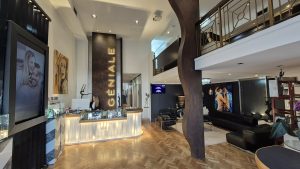Pigmentation Treatment
Professional, clinically guided pigmentation treatments at Géniale, tailored to individual skin types and conditions, with assessments performed by qualified AHPRA-registered practitioners.
Professional, clinically guided pigmentation treatments at Géniale, tailored to individual skin types and conditions, with assessments performed by qualified AHPRA-registered practitioners.

All pigmentation treatments begin with a detailed consultation to assess skin type, history, and pigmentation patterns. This ensures a safe, personalised, and clinically appropriate care plan.
Our treatments are delivered by AHPRA-registered clinicians trained in pigmentation management, following strict safety, ethical, and professional care standards.
We provide aftercare instructions and long-term skin health advice, helping patients understand how to maintain results and minimise future pigmentation changes.

Pigmentation refers to areas of the skin that appear darker or lighter due to changes in melanin, the pigment that gives skin its colour. Common causes include prolonged sun exposure, hormonal changes, post-inflammatory marks from acne or injury, and natural ageing. Pigmentation may appear as freckles, sunspots, melasma, or patchy discoloration. While pigmentation is common and usually harmless, it can sometimes be persistent. Treatments offered at Géniale aim to safely manage pigmentation with medical oversight and clinically appropriate methods tailored to each skin type.
Each pigmentation treatment begins with a clinical consultation to assess suitability. Sessions usually last between 30 and 60 minutes, depending on the method chosen and the size of the area being treated. During the procedure, patients may notice mild warmth, tingling, or temporary redness. Most treatments require minimal downtime, with individuals typically returning to daily activities shortly after. The number of sessions recommended varies depending on the pigmentation type and depth, and this will be discussed during consultation with your clinician.
Pigmentation can appear as freckles, sunspots, age spots or uneven skin tone. It often develops from sun exposure, hormonal changes, genetics, ageing, or skin inflammation. Some pigmentation may be superficial, while other types sit deeper in the skin. An expert clinical assessment is important to determine the type of pigmentation and the most suitable treatment approach.
There are several clinically proven options to help reduce the appearance of pigmentation, including:
The best treatment for you will depend on the type and depth of your pigmentation, as well as your skin type. A qualified practitioner will recommend a personalised plan following a thorough consultation.
The number of sessions required can vary depending on the type, size, and depth of pigmentation as well as individual skin response. Some patients notice improvement after a single treatment, while others may require a series of sessions for optimal results. During your consultation, your practitioner will outline a treatment plan tailored to your skin.
All medical procedures carry potential risks. Common side effects may include temporary redness, mild swelling, or slight skin sensitivity. These generally subside within a few days. Less common risks can include changes in skin pigmentation, blistering, or scarring. Your practitioner will discuss the risks, benefits, and alternatives with you during your consultation to ensure you can make an informed decision.
Results vary depending on the individual, the type of pigmentation, and lifestyle factors such as sun exposure, skincare routine, and hormonal influences. Maintenance treatments and consistent use of sun protection are often recommended to help prolong results.
Downtime differs depending on the treatment chosen. Some people experience little to no downtime, while others may have temporary redness, flaking, or peeling for a few days. Your practitioner will provide clear aftercare instructions specific to your treatment.
Yes, pigmentation can reappear over time, particularly with ongoing sun exposure or hormonal triggers. A good skincare routine, daily sunscreen use, and maintenance treatments as recommended by your practitioner can help manage recurrence.
Most skin types can benefit from professional pigmentation treatments; however, not all methods are suitable for every individual. Certain medical conditions, medications, or pregnancy may influence suitability. That’s why a comprehensive consultation and skin assessment with a qualified practitioner is essential before commencing treatment.
Want to experience Géniale for yourself? Get in touch with us to book yours today. Alternatively, fill out the form to the and we’ll get back to you as soon as possible.
NSW: (02) 9100 0820 or info@geniale.com.au
Géniale Sydney Centre: 137 Victoria Rd, Drummoyne, Sydney NSW 2047
VIC: 1300 27 18 15 or info@geniale.com.au
Géniale Kew Clinic: 176 Cotham Road, Kew VIC 3101
QLD: 1300 27 18 15 or info@geniale.com.au
Géniale Brisbane Clinic: 641 Ipswich Road, Annerley QLD 4103
It’s important to provide your phone number so one of our expert consultants can contact you to provide an in-depth explanation of the procedure.